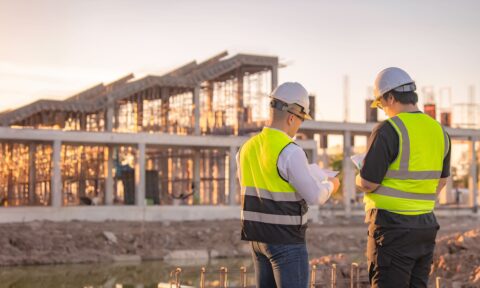Hydroelasticity of Ship and Offshore Structure
- Study ship hydroelasticity for large vessels, focusing on wave-induced loads and vessel response. Design and scantling calculation for large vessels require accurate wave load predictions. Engineers and scientists involved in ship design will benefit from the course. Course balances theory and practice for ship and offshore structure design. Attendees include personnel from ship management, oil companies, and ship builders.
Overview
The Online Hydroelasticity of Ship and Offshore Structure Training Course focuses on the study of ship hydroelasticity for large vessels, emphasizing the importance of predicting wave-induced loads and vessel responses for designing and calculating structures. The course is designed for engineers, scientists, and personnel involved in ship design, ship management, oil companies, classification societies, and shipbuilders. It covers topics such as basic hydrodynamics, seakeeping, hydroelasticity, and numerical methods for addressing hydroelasticity theory. The course is structured to provide a balance of theory and practice over a 2-day duration.
Who should attend
Engineers, Scientists, Ship Designers, Ship Builders, Ship Management Personnel
Course Content
ABOUT THE COURSE
Study of ship hydro elasticity for large vessels is one of the major topic since one decade. In comparison to small or moderately big vessels, container ships are large in size. Therefore, not only they are more flexible in nature, but at the same time the natural frequency of the structures falls in the range of the encounter frequencies which commonly occur in regular ocean.
These can cause significant damage to the hull due to springing, whipping etc. The same can be true for moderately large high speed vessels also. On the other hand, assuming the ship hull to be rigid may lead to overestimation of the hydrodynamic loads or pressure on the structure which can further result in an over conservative design.
Therefore, a proper prediction of the wave induced loads and the corresponding response of the vessel are extremely important for designing and scantling calculation for large vessels.
WHO SHOULD ATTEND
Engineers and scientists involved in the design of ships and ship systems. Personnel from ship management companies, oil companies, classification societies and ship builders will benefit from attending this course. The course is innovative in both content & structure with a careful balance of theory & practice.
PROGRAMME SCHEDULE
Day 1
9.00 – 10.00 Lecture 1: Basic Hydrodynamics 1: continuity equation, momentum equation, concept of velocity potential, stream function, complex potential, discussion on source, sink, dipole, vortex, Conformal mapping.
10.00 -11.00 Lecture 2: Basic Hydrodynamics 2: Linear waves, discussions on the boundary conditions, basic wave forces such as Radiation, Diffraction, Frude- Krylov force etc.
11.00 -11.30 Break
11.30 -12.30 Lecture 3: Seakeeping 1 – Description of ocean waves: regularand irregular, waves: single and multi- degree, equations of motion for a ship
12.30-13.30 Lunch
13.30 – 14.30 Lecture 4: Seakeeping 2 – Ship Motions in regular waves, RAO: Ship motions in irregular waves, response spectra, derived motions.
14.30 – 15.30 Lecture 5: Introduction to Hydroelasticity 1 – Basic definition of the hydroelasticity, Concept of mode shapes, Basic difference with rigid body case.
15.30-16.00 Break
16.00 – 17.00 Lecture 6: Introduction to Hydroelasticity 2 – Derivation of basic boundary value problem, Discussions on different solution methodology
Day 2
09:00-10.00 Lecture 7: Theoretical solution for large floating structure. Eigen function expansion method and similar analytical method will be discussed to address the hydroelasticity of large floating structure.
09:00-10.00 Lecture 8: Semi analytic technique to address hydroelasticity theory.
11.00 -11.30 Break
11:30-12.30 Lecture 9: Coupled BEM FEM based approach for Hydroelasticity
Different numerical approached based on coupled BEM-FEM based method for solving the problem of hydroelasticity of large ships will be discussed. The lecture may cover the following methods, Strip theory based method, Frequency domain panel method, Direct coupled method based on Rankine panel method.
12.30-13.30 Lunch
13:30-14.30 Lecture 10: Time Domain Panel Method for hydroelasticity. 3D time domain panel method
14:30-15.30 Lecture 11: Non-liner hydroelsticity – Nonlinear F-K force, radiation force etc, the effect of Slamming load, Green water load etc.
15.30-16.00 Break
16:00-17.00 Lecture 12: Springing/Whipping Springing, whipping and advantage of the hydroelasticity theory for addressing springing/whipping
CV of Lecturer
Dr. Ranadev Datta is now an assistant professor in the department of Ocean Engineering Naval Architect, Indian Institute of technology Kharagpur, India. He did his PhD in the same department in Numerical Ship and Offshore Hydrodynamics. He worked in IST Lisbon, during 2009 to 2012.
The primary research interest of Dr. Ranadev Datta is related to ship and offshore structure seakeeping, Hydroelasticity. He developed a higher order 3D time domain panel method to solve ship motion problems during his graduation. Presently, his research area includes hydroelasticity, nonlinear fluid structure interaction problem, computational geometry etc
He is now involved in a project supported by the Naval Research Board where they are trying to solve hydroelasticity problem by coupling the boundary element method (BEM) and finite element method (FEM) in time domain. Also working on the nonlinear wave- structure interaction problem; the focus is to find an efficient way to couple the classical potential flow method with popular CFD solvers; so that the local phenomenon such as deck wetness/ slamming can be modelled using CFD.
Dr. Ranadev Datta has worked on several industries related projects. He has helped IRS (International register for shipping) to develop their classification rule book. He also developed stability software for jack up Rigs with Green Palm Marine Consultancy. Apart from that, he did many small scale routine consultancy type project as well.
Apart from his work related to numerical ship and offshore structure hydrodynamics, he is also keen in developing an automated meshing engine for ship like structure using the key concept of computational geometry.
Dr. Datta has several publications in many reputed international journals and conferences such as Journal of Fluids and Structures, Journal of Ship Research, Symposium of Numerical Ship Hydrodynamics etc
Duration:2 Days
Cost: £595 + Vat



